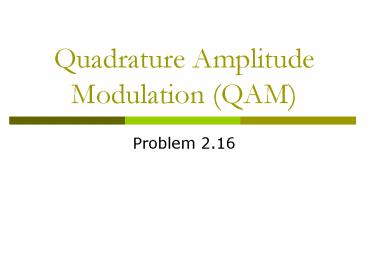Quadrature Amplitude Modulation QAM PowerPoint PPT Presentation
Title: Quadrature Amplitude Modulation QAM
1
Quadrature Amplitude Modulation (QAM)
- Problem 2.16
2
General Problem
- Two i.i.d (independent/identically distributed)
sequences put through a filter - h(n)
- (1/2)n, ngt 0
- 0 else
- Fourier Transform of h(n) infinite, bad for
computation - Need another form that is exact but finite
3
Z-transform
- Thus W(z)H(z) X(z)
- W(z) X(z)/H(z)
- W(z) X(z)/(1/(1-.5z-1)) X(z)-.5X(z)z-1
- W(z).5X(z)z-1 X(z)
- x(n) 1/2xn-1(n) w(n)
- Now have an exact finite form
- Can easily obtain xcn and xsn
h(n)
w(n)
x(n)
4
xcn and xsn
5
QAM
- Each message signal multiplied by a carrier wave,
then summed - cos(np/2) for primary
- sin(np/2) for quadrature
6
QAM, Continued
7
Autocorrelation
- Since signals are i.i.d, their autocorrelation
functions should be flat except near x0.
8
Autocorrelation, Cont.
9
Power Spectra
- Easy to calculate using autocorrelation
- i.e. Sc FRc
10
PSD
11
Power Spectral Density
- Alternate method of calculation
- Sc Fxc2
12
PSD, Continued
13
x(n) recovery
- Normally, need to multiply by cosine or sin
(depending on which signal you want) and then
lowpass the result. - Signal m1(t)cos(2pf0t) m2(t)sin(2pf0t)
- Multiplying by cos gives (reduced via identities)
- .5m1(t) .5m1(t)cos(4pf0t) m2(t)sin(4pf0t)
- Lowpass filter removes influence of m2(t)
- Repeat for sin(2pf0t)
- However, special case here need only multiply
by carrier signals
14
Recovery
PowerShow.com is a leading presentation sharing website. It has millions of presentations already uploaded and available with 1,000s more being uploaded by its users every day. Whatever your area of interest, here you’ll be able to find and view presentations you’ll love and possibly download. And, best of all, it is completely free and easy to use.
You might even have a presentation you’d like to share with others. If so, just upload it to PowerShow.com. We’ll convert it to an HTML5 slideshow that includes all the media types you’ve already added: audio, video, music, pictures, animations and transition effects. Then you can share it with your target audience as well as PowerShow.com’s millions of monthly visitors. And, again, it’s all free.
About the Developers
PowerShow.com is brought to you by CrystalGraphics, the award-winning developer and market-leading publisher of rich-media enhancement products for presentations. Our product offerings include millions of PowerPoint templates, diagrams, animated 3D characters and more.

